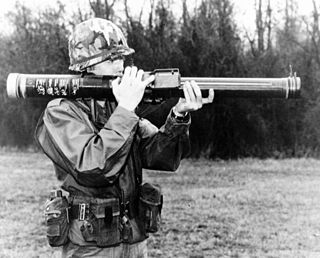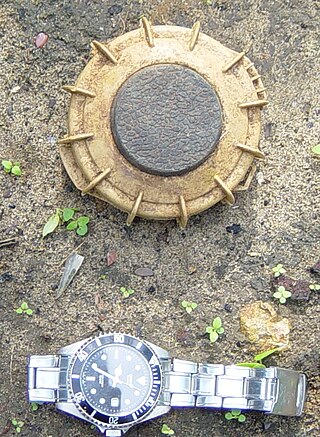
A land mine, or landmine, is an explosive weapon concealed under or camouflaged on the ground, and designed to destroy or disable enemy targets, ranging from combatants to vehicles and tanks, as they pass over or near it.

Armour-piercing ammunition (AP) is a type of projectile designed to penetrate armour protection, most often including naval armour, body armour, and vehicle armour.

High-explosive anti-tank (HEAT) is the effect of a shaped charge explosive that uses the Munroe effect to penetrate heavy armor. The warhead functions by having an explosive charge collapse a metal liner inside the warhead into a high-velocity shaped charge jet; this is capable of penetrating armor steel to a depth of seven or more times the diameter of the charge. The shaped charge jet armor penetration effect is purely kinetic in nature; the round has no explosive or incendiary effect on the armor.

Anti-tank warfare originated during World War I from the desire to develop technology and tactics to destroy tanks. After the Allies deployed the first tanks in 1916, the German Empire introduced the first anti-tank weapons. The first developed anti-tank weapon was a scaled-up bolt-action rifle, the Mauser 1918 T-Gewehr, that fired a 13.2 mm cartridge with a solid bullet that could penetrate the thin armor used by tanks at that time and destroy the engine or ricochet inside, killing occupants. Because tanks represent an enemy's strong force projection on land, military strategists have incorporated anti-tank warfare into the doctrine of nearly every combat service since. The most predominant anti-tank weapons at the start of World War II in 1939 included the tank-mounted gun, anti-tank guns and anti-tank grenades used by the infantry, and ground-attack aircraft.

An explosive belt is an improvised explosive device, a belt or a vest packed with explosives and armed with a detonator, worn by suicide bombers. Explosive belts are usually packed with ball bearings, nails, screws, bolts, and other objects that serve as shrapnel to maximize the number of casualties in the explosion.

The Maschinengewehr (MG) 151 is a belt-fed autocannon for aircraft use, developed in Nazi Germany from 1934 to 1940 and produced by Waffenfabrik Mauser during World War II. It was originally produced in 15.1 mm caliber from 1940, with a 15×96mm cartridge, but due to demand for higher effect against aircraft, especially with the introduction of mine shells for the 20 mm MG-FF/M aircraft cannon, the design was rechambered to 20 mm caliber in 1941, using a newly developed 20×82mm cartridge which traded projectile velocity for explosive power. The initial 15 mm variant then became known as the MG 151/15, with the new 20 mm variant becoming the MG 151/20.

In anti-tank warfare, an anti-tank mine is a type of land mine designed to damage or destroy vehicles including tanks and armored fighting vehicles.

A mine flail is a vehicle-mounted device that makes a safe path through a minefield by deliberately detonating land mines in front of the vehicle that carries it. They were first used by the British during World War II.

The Tellermine 43 was a German circular steel-cased anti-tank blast mine used during the Second World War. It was a simplified version of the Tellermine 42, which enabled simpler production techniques. Between March 1943 and the end of World War II, Germany produced over 3.6 million Tellermine 43s. Several countries produced copies of the mine including Denmark (M/47), France and Yugoslavia (TMM-1).

An anti-personnel mine or anti-personnel landmine (APL) is a form of mine designed for use against humans, as opposed to an anti-tank mine, which target vehicles. APLs are classified into: blast mines and fragmentation mines; the latter may or may not be a bounding mine.

The Goliath tracked mine was a series of two unmanned ground vehicles used by the German Army as disposable demolition vehicles during World War II. These were the electrically powered Sd.Kfz. 302 and the petrol-engine powered Sd.Kfz. 303a and 303b. They were known as "beetle tanks" by the Allies.

The Riegel mine 43 or is a German steel cased anti-tank bar mine used during the Second World War. The mine is a long thin rectangle. It consists of a lower and upper metal tray, and an internal metal-cased explosive block. It uses two ZZ42 fuzes inserted into either end of the internal block, although it can be used with an additional pressure fuze on the top. The mine is similar to the Italian B-2 mine. A variant, the Riegel mine 44 was also produced with a different fuze. Approximately 3,051,400 were produced between 1943 and 1945.

The Panssarimiina m/36 is a Finnish anti-tank blast mine used during the Winter War, Second World War and Continuation War. The mine was the first purpose-built anti-tank mine to enter service with the Finnish Army, and was designed by Lieutenant Colonel T. Raatikainen and Lieutenant Colonel Pylkkänen. Only 5,000 were produced, as the mine proved complex to produce for a number of reasons. The fuze was complex and designed to be interchangeable with artillery fuzes, so artillery shells could be used alongside the mines, also the sheet metal case was hard to produce.

The Panssarimiina m/S-39 and Panssarimiina m/S-40 are Finnish anti-tank blast mine that were used during the Winter War of 1939-1940. Due to the demand for mines during the Winter War, a cheap, easy to produce mine was needed. The m/S-39 was designed by a team led by Major A. Saloranta in October 1939, and it entered production on 8 November 1939. After one week's production at furniture factories in Lahti and Helylä over 2,000 mines had been produced. By the end of the Winter War 133,000 had been delivered. The m/S-40 was an improved version of the mine that differed in detail.

The Anti-Tank Mine General Service Mark II was a British anti-tank blast mine used during the Second World War.

Armoured Vehicle Royal Engineers (AVRE), also known as Assault Vehicle Royal Engineers, is the title given to a series of armoured military engineering vehicles operated by the Royal Engineers (RE) for the purpose of protecting engineers during frontline battlefield operations.

The PAW 600 was a lightweight anti-tank gun that used the high-low pressure system to fire hollow charge warheads. In 1945, it was used operationally by the Wehrmacht in small numbers. Only about 260 were produced before the war's end.

Man-portable anti-tank systems are traditionally portable shoulder-launched projectile systems firing heavy shell-type projectiles, typically designed to combat protected targets, such as armoured vehicles, field fortifications and at times even low-flying aircraft.

The Shitotsubakurai or lunge mine was a suicidal anti-tank weapon developed and used by the Empire of Japan during the Second World War. It used a HEAT type charge. This weapon was used by the CQC units of the Imperial Japanese Army. The weapon itself was a conical hollow charge anti-tank mine, placed inside a metallic container and attached to the end of a wooden stick. The weapon was officially adopted by the Japanese Army in 1944; with the first noted combat use in Leyte in December 1944. During 1945 it caused additional victims in the Pacific Theater, where it commonly saw action against American armour. Later that year, some Japanese Imperial Army manuals of the weapon were discovered by US troops.


















